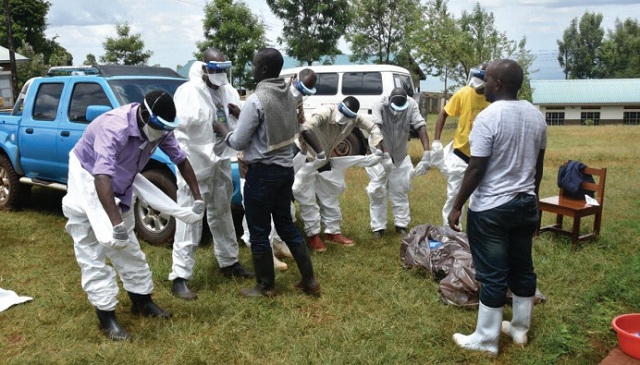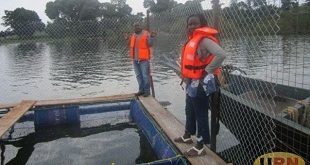
How an oddly timed outbreak is testing emergency strategies
Kampala, Uganda | FLAVIA NASSAKA | On Oct.11, a woman died in Chemuron village, Kween District in an Eastern Uganda. She had a fever, headache, and was bleeding from several places. Doctors attending to her had feared the worst and sent her samples for testing. A week later, on Oct.17, experts at Uganda Virus Research Institute (UVRI) confirmed the 50-year old woman had succumbed to a high mortality hemorrhagic fever – Marburg.
The timing could not have been worse as the Ministry of Health officials had their hands full. They were at this time finalising preparations to host Health Ministers from over 40 countries across the world to share notes on, among others, how to handle public health emergencies.
The Ministry of Health switched on its standard emergency responsible for hemorrhagic fevers. An alert warning the public to take precaution was issued and a Rapid Response Team comprising of epidemiologists, laboratory specialists, and infection control experts was dispatched both to Kween, 300kms from Kampala, and the neighboring Kapchorwa District. Their mission was to ensure those who present with symptoms are managed promptly. Since intervention inevitably involves isolation, an isolation ward was set up at the Kapchorwa General Hospital and at Kaproron Health Center IV. Those suspected to be infected would be monitored here. Healthcare managers and local leaders embarked on sending out messages encouraging people to report any suspected case to a nearby facility.
Soon, the story took an even trickier twist. Another suspected patient went into hiding when he realised he was going to be isolated. The 38-year old man was a brother to the initial confirmed case but he refused review and resorted to hiding from the surveillance team. To the Minister of Health, Dr. Jane Ruth Aceng, this was an emergency piling on an emergency.
Like Ebola, Marburg which is believed to be spread by monkeys and bats is transmitted through direct contact with blood, secretions and other bodily fluids of an infected person or animal and it is very contagious. The first outbreak was reported in the 1960s in Marburg Germany where scientists were conducting a study that involved monkeys from Uganda. Officially, therefore, the disease has been around for over 50 years. In Africa, severe outbreaks have happened in the Democratic Republic of Congo involving 154 cases of which 128 were fatal representing a case fatality of over 80%.
According to World Health Organisation, because the disease is rare, scientists are just starting to do candidate experimental treatments. Potential vaccines are being reviewed for potential clinical trials.
Currently, anyone coming into contact with a suspected case has to be isolated and monitored by professionals. So, Aceng told The Independent, a suspected patient evading surveillance and hiding was scary because it is such procrastination and denial that turned the West African Ebola scenario into a serious epidemic.
“Containing Marburg or any other hemorrhagic fever is a race against time by health workers,” Aceng said, “any laxity can easily plunge the country into a crisis.”
Fortunately, the man came out of hiding a week later, on Oct.24, when his condition began deteriorating and gave in to being admitted. He died two days later.
By Oct.26, two cases had been confirmed. Four were suspected, three were probable cases and six had been released from the isolation centers after they tested negative. The total number of contacts under follow up stood at 13,085 from Kween, and 45 from Kapchorwa district.
Meanwhile, another team of health officials set off to find the likely first source of the outbreak. Usually, this involves tracing backwards to whom any suspected cases might have been in contact with. This means following numerous leads of investigation.
Soon, however, Ministry of Health officials had zeroed-in on the probable first case – by combing through hospital records of recent patients. The suspected first case, the say, was a male in his 30s who worked as a game hunter and lived near a cave with a heavy presence of bats.
On Sept.20 he had been admitted to a local health facility with high fever, vomiting and diarrhea, and did not respond to antimalarial treatment. As his condition deteriorated, he was transferred to the referral hospital in the neighboring district, where he died. This case was never confirmed for Marburg because no tests were done.
“We always defeat the virus is because they are always on high alert,” Aceng says. In the current case, however, she notes that the disease breaking out in a border district presents another challenge for the Ministry of Health. They have to ensure that there’s no cross border transmission. This to Aceng means having a vigilant team that can easily spot symptoms of the disease which might not be easy, as the disease most times has similar symptoms to other common and treatable diseases.
Dr. Julius Lutwama, a virologist at the Uganda Virus Research Institute says symptoms in the early period of the disease include patients appearing pale with deep-set eyes. They also experience extreme weakness coupled with lack of appetite. He says unlike other fever causing diseases, Marburg is often associated with significant bleeding from multiple sites on the body during days 5 to 7 of the onset of the illness.
Uganda has been applauded internationally for managing such emergencies that the country’s reporting tools and standard operating procedures were employed in West Africa in 2014 to manage Ebola. That year, Uganda was one of the countries chosen as a Global Health Security demonstration centers because of its successes including establishing an Emergency Operations Centre to co-ordinate information flow and response activities for public health threats.
With its tactic of immediate response, the country has knocked the disease in a timely manner thrice. First was in 2007 where four cases were recorded with two deaths in a western Uganda district of Ibanda. In 2012, fifteen cases including four deaths were recorded in western Uganda and two years later in 2014, another outbreak hit claiming one person a health worker operating in Mpigi district.
Ministry of Health tips to manage Marburg
– Report any suspected patients immediately to a nearby health facility.
– Avoid direct contact with body fluids of a person presenting with bleeding tendencies or symptoms suggestive of Marburg virus disease.
– Health workers should wear gloves and appropriate Personal Protective Equipment (PPE) when taking care of ill patients or suspected cases.
– Regular hand washing is required after visiting patients in hospital, as well as after taking care of patients at home.
– Avoid contact with persons who have died from the disease.
– Allow health workers to perform dignified burials among victims who might have succumbed to the disease, so as to minimise its spread to others.
 The Independent Uganda: You get the Truth we Pay the Price
The Independent Uganda: You get the Truth we Pay the Price



